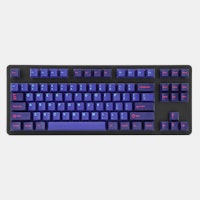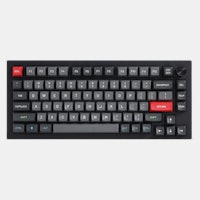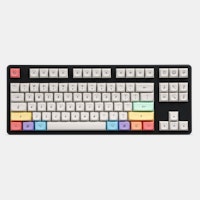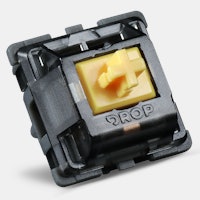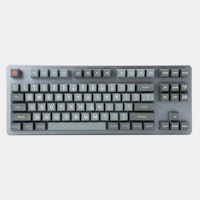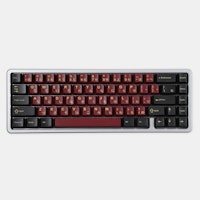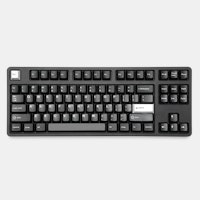Click to view our Accessibility Statement or contact us with accessibility-related questions












We Know Nothing About Switch Materials

Figure 1: A fantastic Kailh switch photo from Blitzenx51!
There’s any number of different details people look into when they’re trying to pick out switches for their next keyboard build. However, arguably none of them are as vague and mysterious as the materials used to make housings and stems. Yes, even as manufacturers are iffy about their spring weights and newer brands are sketchy about who actually made their switches, differentiating POM from Nylon from Polycarbonate remains to this day the least understood parts of mechanical keyboard switches. For what it’s worth, I don’t have a fix for that either. As someone who has completed a master’s degree in chemical engineering focusing on polymer science, I understand full well that attempting to reverse engineer the formulas of even the most simple keyboard switch materials would take months on end and nearly free-range access to numerous analytical instruments that companies simply won’t hand over to you. However, that does not stop plenty of armchair chemists within the hobby from throwing in their two cents on the matter. Hoping to try and correct some of those erroneous claims and get you pointed a bit more in a levelheaded and correct direction on switch materials, let’s take a look at why switch materials are a bit more nuanced than you may think.

Figure 2: Iconic switches of specific materials including Cherry MX Greys (Nylon), Novelkeys Creams (POM), and Tealios (Polycarbonate).
Mechanical keyboard switches are largely made of one of three common thermoplastics, or plastics which can be melted and recast: POM (Polyoxymethylene), Nylon (Polyamides), or Polycarbonate. Differences between each of these plastics with respect to their molecular chemical structure grant them differences in their strength, density, resistance to breakage, and even smoothness when shaped into specific forms. It’s not uncommon for modern switches to have components made of different materials, so it’s not correct to necessarily assume that the housing of a switch is the same as its stem. In fact, the vast majority of switches have stems made out of POM whereas their top and bottom housings may be made of Nylon or Polycarbonate, for example. While the properties of these materials and their associated, keyboard-related properties such as sound and smoothness are a function of both the material and its shape/size/maker, the keyboard hobby as a whole has come to attribute certain sound characteristics to various types of switch materials. You may have heard some of these claims already, in that Nylon housings tend to have a “deeper, more firm, and almost muting” type sound to them whereas Polycarbonate housings tend to have a “higher pitched, thin, and sharp” type sound to them. These claims certainly aren’t wrong in the case of respective classic examples which have helped shape these ideas – such as the Nylon housings of classic Cherry switches or the Polycarbonate housings of original Zealios – however they often aren’t mentioned with conflating factors that help influence those sound characteristics.
In addition to the thermoplastics used in the creation of various switch housings, there are a ton of conflating factors which can affect their sound or smoothness including, but not limited to, the mechanical thickness of the components, the manufacturer, or even the age of the source of the materials used in the switches! Pointing back to the classic adage of “deep and muted” sounding Cherry housings, people often assume that this is just a function of the use of Nylon in their construction. However, the actual density and shape of the housings in Cherry’s molds are noticeably different from those of Kailh or Durock/JWK, other manufacturers who also make switches with Nylon housings. Hell, even the differences in how much Nylon Cherry may use in their formula (for example 95%) as compared to another manufacturer (who may use 85%) could influence the sound that these switches make more than anyone ever realizes. So for this reason, while we can draw general trends between how a switch may sound and the material that the manufacturer says they used to make them, we really know (almost) nothing about how much of a difference those materials make. There’s even good reason to believe that the materials used by certain manufacturers have changed over the years of production and that the switches in our very own keyboards continue to change and age with time – just take Gazzew’s Boba switches as a prime example of such…

Figure 3: Example of newer (Left) and older (Right) Gazzew Boba switches showing age-based yellowing.
For those of you who are immediately going to go start looking at the materials used in each and every switch you come across now, I hate to inform you that the problem of lack of knowledge on the community’s part is actually worse than I have portrayed it in the last few paragraphs. In addition to POM, Nylon, and Polycarbonate, manufacturers in recent years have begun introducing proprietary mixtures that are simply labeled as ‘mixed housing materials’ and ‘blended housings’, which leads to an entire spectrum of different materials that are being used in keyboard switch housings. Obviously not wanting to disclose this information since this is how quite a few manufacturers help promote more premium switch lines and/or gain a leg up on their competitors, they’re not exactly keen on plastering those chemical compositions on the sales page. So what can you really do to try and make your way around in this sea of confusing plastic combinations? Honestly, your best bet is to simply buy small quantities of switches you’re interested in and try them for yourself. Trying some Cherry switches made of Nylon and some Gateron switches made of Polycarbonate is your best way to try and gain an understanding about how that manufacturer and their material behaves, and can only further deepen your ability to draw inferences from future sales posts from those manufacturers. Unfortunately, there’s very little I can do without rigorous scientific analysis of the materials used in switches to help you out without boldly lying to you. Like most good things in the keyboard hobby space, it will have to come down to preference and personal experience.

Figure 4: And unfortunately the list of potential switch materials is even more vast...
I know this article was a bit more doom and gloom than most beginner’s guides and introductory ones I’ve written previously, but quite frankly it needs to be said. There’s no substitute for personal experience when it comes to mechanical keyboard switches, and no amount of content creators out there will substitute for it. With so much misinformation out there about switches, it’s hard to keep people newer to the hobby from falling into that rabbit hole of generalizations. If you are one of those people new to the hobby and trying to cut through the fluff around switch marketing a bit, why don’t you check out my article on ‘Switch Marketing Terms: What to Know and What to Ignore’ or ‘Switch Myths That Aren’t Actually True!’.
(Edited)

search
close
Sort by: Newest
keyboard_arrow_downericmci
0
Apr 5, 2024
Hi- Do you happen to know anything about the toxicity level of full POM switches - being that pom can release formaldehyde when mechanically abraded. I doubt typing is enough to do that but still it makes me wonder.
Thanks!

MonetsChemist
73
Oct 30, 2023
Thank you for being one of those rare people online these days who shares information as opposed to (ill-informed) opinion.

Trevorplease
59
Sep 29, 2023
Which switches have the top of the pyramid in Fig 4? I want the top of the line high performance engineering polymers :)
(Edited)
PRODUCTS YOU MAY LIKE
Trending Posts in Mechanical Keyboards

RealRage_TV
software?
Hi I'm new to Drop and i just received my Keyboard i have been waiting for months for by Drop x MTN Dew x Borderlands movie and didn't know if there was a software like Logitech's for the keyboards. if anyone could help please let me know
Nov 20, 2024

jdsvdropper
Drop ENTER keyboard with DCX Sleeper Mac variants and Rocky Bird
Black Drop ENTER keyboard with DCX Sleeper Mac variants for the Option and Command keys, and Rocky Bird red and black DCX keycaps.
Nov 19, 2024
AngryTank
Favorite Artisans
COME FORTH SHENRON!
Purple, Dragon Balls, and Seta! What more does a simple man need?
Nov 17, 2024
InsufferablePedant
ZealPC Aqua Zilents
Please ignore the filthy keyboard, it's been on a shelf for a minute.
Nov 15, 2024

Neekolas714
Kicks & Keebs
Alpha Bravo Smoke
Finally finished my Keychron V5. Smooth, beautiful and stylish. What else could there be?
Nov 13, 2024

